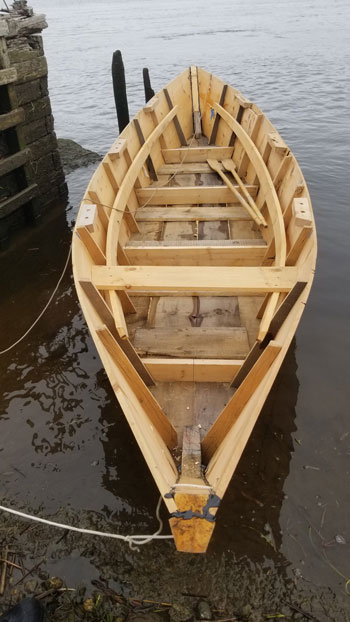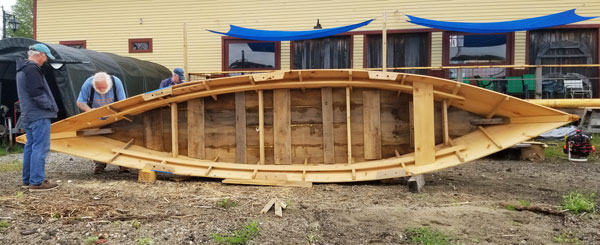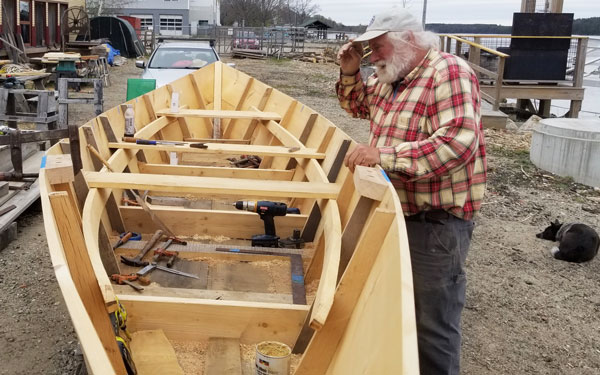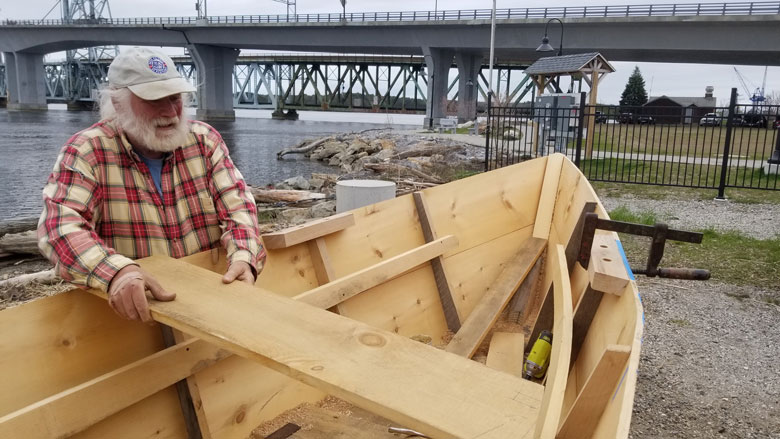“You can take Quebec City on a Saturday,” declares Rob Stevens, who is standing beside a wooden boat he’s in the process of completing behind the home of Maine’s First Ship along the Kennebec River in Bath.
Depending on your definition of what it means to “take Quebec City,” you could say the shipwright from Woolwich is talking from experience. In 2017, he and four other men followed the grueling route Benedict Arnold and 1,100 men (and a couple of women) took through Maine’s wilderness to Quebec in 1775 with the intention of capturing the city from the British.
The “taking” of Quebec City by Stevens and his four comrades more than 240 years later on Saturday, Nov. 4, 2017, involved an “assault” by river on the Canadian Coast Guard’s icebreaker, the Pierre Radisson. After banging on the side of the 322-foot-long ship with an oar, “Nothing happened,” Stevens says, “and that’s why I say you can take Quebec City on a Saturday.”
The expeditionary force faced whitewater in the rivers which bashed their bateaux (and themselves) to pieces.
The assault then included an arduous climb up the “secret path nobody knows about” (a.k.a. the Cap-Blanc stairs) to the Plains of Abraham, and a “storming” of La Citadelle, capped by the five drunk men exposing their bare arses in the direction of the barracks representing the long-ago British enemy .
“I’m not kidding when I say I was not drunk,” declares a straight-faced Stevens, “but the other four guys were smashed.”
The bateau Stevens built for that 2017 trip serves as a model for the one he is building today. This bateau, at 22 feet and made mostly of pine, will be used not for a repeat of the 350-mile journey to Quebec (although Stevens is game for another go at it) but as the basis for other bateaux Stevens and members of the Arnold Expedition Historical Society hope will be built as part of the society’s celebration next year of the 250th anniversary of the Quebec campaign.

As a little history refresh: At the start of the American Revolution—a year before the Declaration of Independence—Benedict Arnold proposed to George Washington that he take a force through the Maine wilderness via the Kennebec and Dead rivers to seize Quebec and thwart the British.
Arnold and his army were outfitted with funds and supplies, including 220 bateaux made at the home and shipyard of Reuben Colburn (now a state historic site and museum) in present-day Pittston.
To say the expedition to Quebec that began in late September 1775 on the Kennebec River outside Colburn’s home was miserable is an understatement. The expeditionary force faced whitewater in the rivers which bashed their bateaux (and themselves) to pieces, snow and freezing temperatures, and a massive storm that resulted in the loss of supplies and provisions.
Disease, injury, death, and the decision by some of the expedition leaders to turn around meant that fewer than half of those who began the expedition made it to Quebec, says Tom Desjardin, a Maine-based author who wrote the book Through a Howling Wilderness about the expedition.
“People died of about everything you can die of in the Maine woods,” he says. “They died of freezing, they died of drowning, they died of disease, they died of everything but a bear attack.”
Despite the reduced force, Arnold and his army still made it to Quebec and attempted capturing the city, but both attempts failed (in deference to Rob Stevens, it must be noted that each of those attempts began on a Sunday).
The “failure” to seize Quebec for the Americans really wasn’t a failure at all when placed in the context of all that followed, says Desjardin, but the story of the expedition—essentially the first major military campaign of the American Revolution—doesn’t get the attention it deserves because of Arnold’s later betrayal when he switched sides to support the British.
“The reason there was a Saratoga was because Arnold and his army tried but failed to walk to Quebec and take the city,” Desjardin says. And if it wasn’t for Saratoga—when the American military captured an entire British army, which convinced the French to provide support—the Americans would likely not have prevailed against the British, he notes.
The Arnold Expedition Historical Society has been trying to raise the profile of the Quebec campaign through Maine since its founding in 1973. With the 250th anniversary coming up and the Reuben Colburn House still closed due to a need for major renovations, the society is hoping to bring attention to the expedition and Maine’s role in it, and to raise funds, says Mike Holt, one of the society’s members.

Part of that effort will be next year’s events. Those are still in the planning stages, says Holt, but members are talking about holding poling and rowing competitions, including some more strenuous challenges such as portaging around obstacles, and maybe even a cooking competition to include creative recipes such as “right-shoe soup,” jokes Holt, in reference to the starving men of the 1775 expedition who did resort to eating their shoe leather.
The society is also partnering with Maine Maritime Museum in Bath to sell bateau kits. The boatshop at the museum has offered to create the kits based on Stevens’s design for those who want to build a bateau but don’t have the resources to do so. Society members hope that a handful of nonprofit organizations will build bateaux that can later be placed on public display at a variety of locations.
Those interested in a bateau kit or in participating in next year’s events should contact the Arnold Expedition Historical Society at arnoldexpedition250th@gmail.com.






